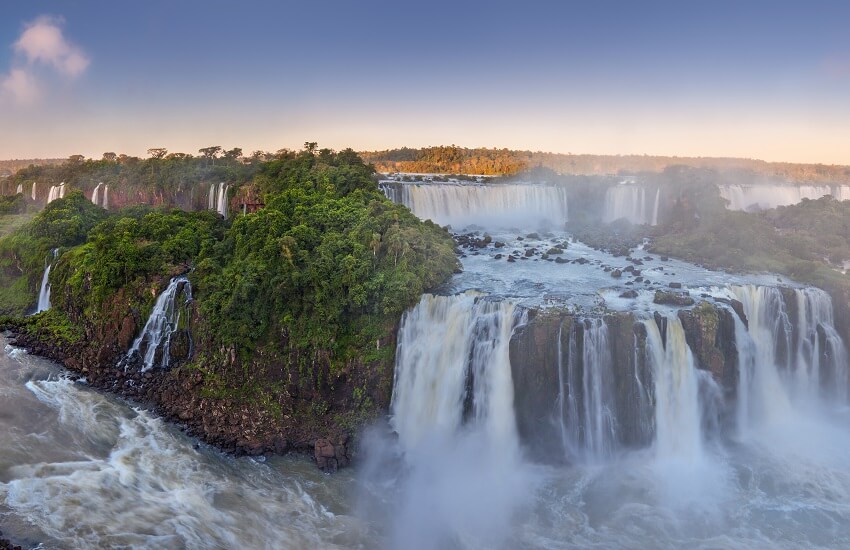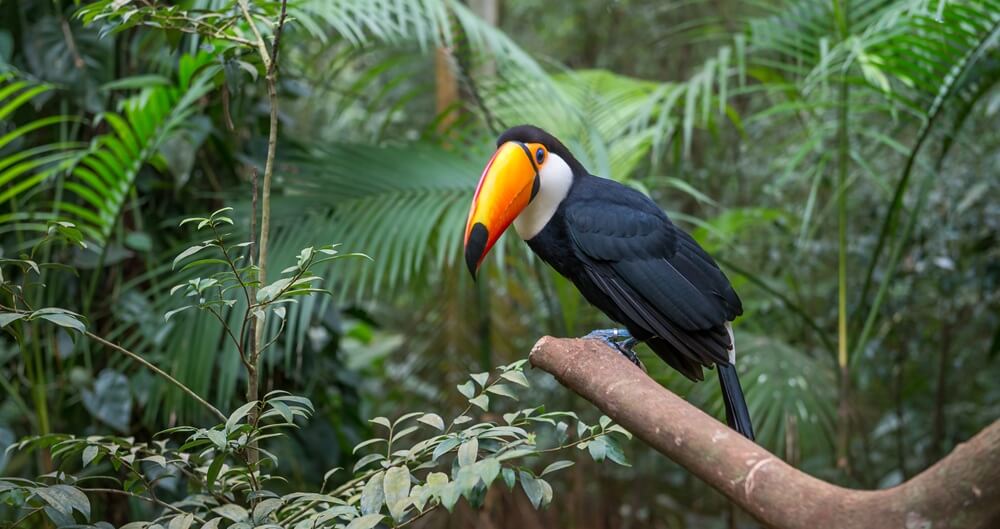


You might have been to the impressive Niagara Falls or even the stunning Victoria Falls, but the most dramatic waterfalls in the world must surely be the Iguazu Falls, which straddle the border of Brazil and Argentina in South America (also known as the Iguassu or Iguaçu Falls).
Stretching for 2.7 kilometres in width, the chain of waterfalls varies in height from 60 to 82 metres, making them nearly twice as tall as the Niagara Falls and almost three times as wide. Although the Victoria Falls are taller than Iguazu, it is the width of these South American Falls that is so spectacular, as the whole panorama is filled with cascading waterfalls.
The amount of water pouring from the Falls into the Iguazu River is equally staggering. On average, about 1,500 cubic metres of water flows every second. Depending on the time of the year, the rate of water flow can be as much as 13,000 cubic metres per second — enough to fill five Olympic swimming pools— especially during the rainy months of November to March!
Read on for our guide to experiencing the magnificent Iguazu Falls, from both the Argentinian and Brazilian sides, including the best time to visit, what to see, and how to get the most out of this incredible destination.
TL;DR Visiting the Iguazu Falls: Iguazu Falls deserve more than a quick visit. We recommend 2-3 nights on the Argentinian side for the full experience via walkways and boat rides for a really close-up experience. The Brazilian side offers stunning panoramic views and is ideal if you want to experience the falls but are short on time, or as an additional day trip to combine with a visit to the Argentinian side. Visit year-round, with March-August providing cooler, quieter conditions and incredible rainforest wildlife.
The Iguazu Falls are not a place you could only spend a couple of hours visiting and tick them off your bucket list – they demand so much more than that! With totally different viewing experiences from either side of the Falls, you can easily spend two days viewing them, and after that, there’s so much to see in the rainforest as well including venturing into the rainforest.
For the ultimate Iguazu experience, we recommend focusing mainly (if not solely) on the Argentinian side, particularly if you have 2-3 nights available as part of your trip. This gives you the chance to get up close to the Falls and really explore them all, or at least the best of them, gaining a real sense of their power.
The network of walkways on the Argentinian side takes you right out over the water to the edge of some of the Falls – sometimes just an arm’s length away – so you can witness the Falls looking down from over the top. Some walkways run around the bottom (lower circuit) and the top (upper circuit), plus the famous Devil’s Throat, which takes you right over the main waterfall. Shaped like a horseshoe, the Devil’s Throat is the largest waterfall in the whole system, and with its drop of more than 80m, it creates a permanent cloud of mist. The experience here is extraordinary – it’s so loud you can feel the vibrations running through you, which is genuinely impressive. You can also take speedboats to the Falls, including several smaller waterfalls, but be prepared to get absolutely drenched as the boats take you right under the water!

Beyond the Falls themselves, there are jungle trails perfect for wildlife spotting and an eco-train ride that takes you through the rainforest, offering close-up views of wildlife and different angles of the Falls, all designed to have minimum impact on the environment.
On the Brazilian side of the Falls, you can enjoy a more complete view of the Falls thanks to impressive viewing platforms from the other side of the river. If you’re short on time and want a quick way to take it all in, Brazil offers an easy and efficient option, albeit it doesn’t offer the opportunity to get as close to the action as in Argentina. From the shorter network of walkways, you may be further away from the water, but you will be able to enjoy a spectacular panoramic view. The view of the Devil’s Throat from this side is quite dramatic as the Lower Balcony takes you almost to the face of the Falls. You’re also still surrounded by rainforest here, so there are plenty of jungle trails and hikes to enjoy.

Although some of our clients choose to visit both sides of the Falls, this isn’t strictly necessary, as the Argentinian side provides a fully immersive experience. But if you’re keen to experience both sides, you could stay on the Argentinian side for 2-3 nights and then nip over to Brazil for a couple of hours – it’s an easy trip that can be arranged.
It is probably the remote location of the Falls that has kept them from being more commercialised, however, this is also what makes them so special. Instead of being surrounded by casinos, hotels, fast food restaurants and theme parks, the Iguazu Falls are located in one of the few remaining inland rainforests in South America. The lush, subtropical national parks of the Atlantic rainforest, which surround the Falls, are teeming with wildlife and have been preserved by both Argentina and Brazil.
From Buenos Aires, it is a 90-minute flight to Puerto Iguazu on the Argentinian side, and from Rio de Janeiro, it takes two hours to fly to the Brazilian town of Foz de Iguacu.
When it comes to timing your visit, the Falls can be enjoyed year-round, as the weather isn’t a major issue that will prevent you from exploring them. Summer (December-February) can get hot, humid and busy, but the Falls are at their fullest, and it is a popular time to visit. March-August offers cooler and quieter conditions, making it ideal for lots of outdoor activities, although the latter part (the UK summer) isn’t the best time for South America generally. September-November provides pleasant weather that’s not too hot or humid, with some rain.
The Falls are a haven for more than 2,000 plant species, about 400 bird species, 80 types of mammals and countless insects and invertebrates. Keep your eyes peeled for coatis, monkeys, capybaras and reptiles. If you venture further into the rainforest, you might even spot the very rare jaguars and wild cats that call this region home.

Birdwatchers will be in their element with toucans, macaws, and parrots to spot, and if you’re lucky, you might catch a glimpse of the harpy eagle. The forest is also alive with hundreds of butterflies, caimans (which look like small crocodiles) in the waterways, and lots of smaller creatures. We recommend a guided tour to help give you the best chance to spot this region’s wildlife.
The Falls are perfectly positioned for incorporating into a Brazil, Argentina and Chile itinerary with direct flights readily available. While it’s also accessible from other South American countries, you’ll probably need to factor in indirect flights for these routes.
We find Iguazu works beautifully as part of a classic South American triangle, combining the vibrant cities of Buenos Aires and Rio de Janeiro, or as an incredible contrast to the wine regions of Mendoza. If you’re looking at a longer South American adventure, you could also combine it with Chilean highlights such as Santiago, the Atacama Desert, or Patagonia.
Make sure any trip you plan to Argentina or Brazil includes a few days visiting these magnificent Falls – we promise you won’t be disappointed. Take a look at some of our favourite South American itineraries that offer a visit to Iguazu Falls as part of your holiday.
Inspired by the guide? We’ve handpicked a few holidays that bring it to life—perfect for turning travel ideas into reality.